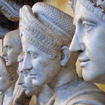TP8-Grammar (Writing)
Intermediate (B1) level
Description
Materials
Main Aims
-
To provide practice of the passive form of 'to be' in the context of historical events and/or stories.
Subsidiary Aims
-
To provide accuracy writing practice in the context of story-telling.
Procedure (45 minutes)
T drops a pen on the floor. T asks sts to state what just happened in one sentence, using T's name as the subject ("Aylin dropped a pen on the floor"). Write this sentence on the board. Ask students to identify the subject and the verb in this sentence (subject = “Aylin”, verb = “dropped”. T drops pen again. Asks sts to again state what happened, but this time starting the sentence with, “The pen…” (“The pen was dropped on the floor.”) Ask your students to identify the subject ("pen") and the verb ("was dropped"). Write it on the board. T asks sts to look at the two sentences and compare. "How are they different?" CCQ: "is the subject doing the action in the first sentence?" (yes) **T explains that subject is active, the one responsible for carrying out the action.** CCQ: "Is the subject doing the action in the second sentence?" (no) **T explains that the subject is passive, the one who is being acted upon.** T elicits what tenses are used in both sentences (first = past simple, second = passive past simple) T drops several pens. T elicits active and passive sentences from sts, emphasizing 'were' to imply plurality ("Aylin dropped many pens on the floor."/"Many pens were dropped on the floor.")
T gives sts HO1. Instructs them to work on their own and underline the 7 uses of passive past simple tense within the text from the lesson before. Sts check in pairs for 1 minute before checking their answers from the answer key on PPT (slide 1)
Break down grammar on WB. T shows slide 2 on PPT, and has elicits sts aid in identifying the subject, object, and passive/active verb, and syntax structure in each sentence. Active: My mother took this photo in Germany (S + active verb + Object) Passive: This photo was taken in Germany (S + passive verb) *Can be any tense, for the passive verb; but the subject must not be doing the action itself. The action was done, is being done, or will be done to it.* Passive: This photo was taken by my mother. (S + passive verb + by + agent) *if we want to say who did the action, we can use 'by + agent' after the passive verb.* *We use the passive when it isn't important who did the action, we don't know who did the action, or the action is more important than the person or the thing that did it (the agent)* *we use passive voice in formal speech and writing most often* (e.g. writing about historical events, writing formal requirements, etc...) _________________________________________________________ T opens slide 3 and shows example sentences to sts. T asks sts if these are passive (yes, all of them). T asks sts to identify what tense they are (past simple, present perfect, present continuous/progressive). Underline the subject in each sentence and ask the same CCQ: "Is the subject doing the action?" (no, for all). CCQ: "Do we know who took the photo in these sentences?" (no) "Is it important?" (no, we understand what happened just the same) "Do we know who changed parts of the photo in this sentence?" (no) "Is it important for us to know to understand what happened?" (no)
T gives sts instructions to work in pairs to complete HO2, pt 2. They have 5 minutes to complete the controlled grammar practice. When finished, pairs can check with the other pair across from them at their table of 4.(make sure they are sitting at tables of four). Sts then will check their answers from an answer key (PPT slide 4) CCQ if there are any questions or debates about an answer, using same CCQ's from above. Read excerpt aloud from activity: "His most famous photograph (elicit answer here: was taken) in New York's Time Square on V-J day, celebrating the end of World War II. Eisenstaedt (elicit answer: did not get) the names of the people in the photograph and since then many different claims (elicit answer: have been made) about their identities" Do we know who took the photograph? (yes) Do we know who the people in the photograph are? (no). T shows slide 5. T asks sts who they think that the people in the photograph are. What is their story? T asks sts to discuss their ideas at their tables for 2 minutes.
T instructs sts to turn their HO2 over to complete part 2 individually for 5 minutes. T DOES FIRST QUESTION AS AN EXAMPLE WITH STS. Sts check in pairs. T shows answer key on board. CCQ with any answers that sts may have gotten wrong and/or just choose a few randomly and clarify meaning. T shows sts the picture on slide 8 (PPT) that is described in the activity). T asks sts if they think that the photographer (Liu Weiqiang) was trying to trick people or not into thinking the photo was real. "Do you think manipulating photos is art or trickery?" Sts talk about this with their groups for 1 minute.
T tells sts that they are going to use the passive voice to write a story now, keeping in mind all the rules that we've learned about using the grammar. (slide 8) T hands out HO3, and asks "What tense are stories usually told in? (past simple, etc)." Informs them that they must include at least 3 passive voice sentences in their stories. T monitors story writing and does delayed error correction on the board. When finished writing, sts hang their stories up on the wall and they all go and read each others.

